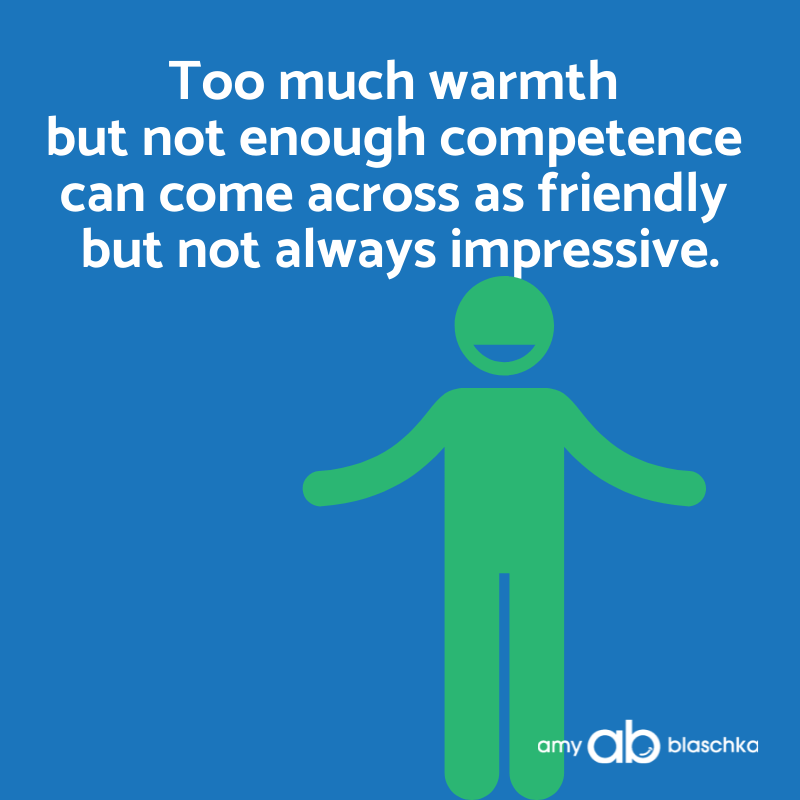Get a cue
How to balance your nonverbal cues to convey power, trust, leadership, likability, and charisma in every interaction
Raise your hand if you’ve ever had to sit through a mind-numbingly awful presentation.
(I know I’m not alone here.)
Let me guess: the speaker (who should be referred to as the “reader” because it better describes their delivery) wasn’t connecting with (or looking at) the audience and didn’t seem confident in their material.
Or maybe you’ve experienced this with someone you knew was highly intelligent but came across as cold and aloof.
Or perhaps you’ve attended a presentation where you really liked the friendly speaker but secretly questioned their authority.
The truth is you can have the best ideas in the world, but they’re worthless if you don’t know how to communicate them.
The reason why some people seem to share their ideas effortlessly, engaging their audience and building their reputations as credible thought leaders while others struggle isn’t a fluke.
The secret, says Vanessa Van Edwards* in her latest book, Cues: Master the Secret Language of Charismatic Communication, is they’ve learned to pay attention to and master their cues.
Edwards cites a groundbreaking study from Princeton University that found highly charismatic people demonstrate a unique blend of two key traits: warmth and competence. Those with both signal trust and credibility and make people see them as friendly, smart, and collaborative.
The problem? Most of us have an imbalance between these two traits — and it’s negatively affecting the way others perceive us, says Van Edwards.
and…
but…
The most charismatic leaders understand how to balance their cues. Let’s break them down:
WARMTH CUES
Highly competent, but people feel you’re unapproachable? Try adding a few of these warmth cues to the mix to signal more trust, collaboration, and openness:
Titling - Tilting your head shows interest, curiosity, and appeasement. (Pro tip: consider adding a photo to your LinkedIn profile with a slight head tile and genuine smile to up your warmth cue.)
Nodding - Affirmative nodding signals and triggers empathy.
Eyebrow Raise - Raising your eyebrow shows interest and curiosity and captures attention.
Smiling - Genuine smiles spread and create joy, helping others feel happy too. And those that take longer than half a second (called savor smiles) are the best.
Touch - A subtle and strategic touch (think: handshake, high five, fist bump, pat on the back) increases trust.
Mirroring - You wow others and earn their respect by meeting them where they are, subtly matching their behaviors. Mirroring positive body language signals alignment and agreement.
COMPETENCE CUES
If you’re naturally warm and you know you’ll be interacting with someone higher in competence, be sure to incorporate some of these cues to boost your presence:
Power Posture - Expansive posture (standing up straight with your feet apart, for example) helps you look and feel more powerful. And confident posture helps you inspire confidence.
Flexed lower eyelid - Narrowed eyes (also called a “smize”) signal intensity, focus, contemplation, and scrutiny.
Steeple - Palms facing with fingertips gently touching is a universal display of confident contemplation and convinces others of your commitment.
Explanatory gestures - Purposeful, confident hand gestures (think holding up fingers while counting or emphasizing your message with a softly closed hand and thumb pointing) help others understand your message better.
Palm flash - When you flash your palms, people pay attention.
CHARISMA CUES
In addition to warmth and competence cues, Van Edwards suggests incorporating these highly charismatic nonverbal cues:
Leaning - Leaning in is the fastest way to look and feel interested and engaged.
Fronting - If you want someone to feel heard, accepted, and respected, turn toward them.
Anti-blocking - To inspire openness, open up nonverbally, removing any barriers (crossed arms, a laptop, or podium).
Space Smarts - Physical distance equals emotional distance. If you’re too close too soon and you’ll make others nervous; too far, and you’ll have a more challenging time connecting. The sweet spot is about 1-1/2 to 5 feet from someone.
Gaze - Making eye contact is essential for connection, plus gaze is the ultimate attention cue; we look to where someone is gazing to understand what is most important.
DANGER ZONE CUES
While under-signaling is a problem, so is unintentionally signaling anxiety, shame, and guilt cues. Watch for and try to avoid these red flags:
While under-signaling is a problem, so is unintentionally signaling anxiety, shame, and guilt cues. Watch for and try to avoid these red flags:
Distancing - Things like stepping or leaning back, turning away, or checking your phone when you’re with others create emotional distance making you less charismatic.
Self-comfort - Rubbing your arms or neck, cracking your knuckles, or touching your nose distract and detract from your charisma, making you look anxious or unsure.
Blocking - Blocking our body (arms crossed over chest), mouth (hand over mouth), or eyes (shielding eyes with a hand) makes us feel protected but signals close-mindedness.
Shame touch - Putting both hands to your forehead and looking down signals shame and nervousness.
Bothered face - Be aware of what cues your face is sending at rest and avoid accidentally signaling anger, sadness, and contempt.
Another thing to pay attention to that will help your career? Your perspective.
ICYMI, in my recent Forbes article, I shared five simple but effective ways to reframe your thinking and transform your mindset during these trying times.
One more reason to pay attention to your cues:
For better or worse, the impression you make on someone lingers far beyond your initial encounter with them, sometimes your entire career.
And in my latest Forbes article, I share six ways you can be memorable for all the right reasons.
Shine on,
Amy
P.S. When I’m not writing this newsletter or picking up on social cues, I’m a social media ghostwriter. (Yep, that’s a thing). I help founders, entrepreneurs, and CXOs craft their stories to communicate and connect better by magnifying their reach and impact. (Think personal branding and thought leadership.) Learn more here.
P.P.S. Now that we’re inbox-exclusive (love that about us!), why not follow my musings across the interwebs on Forbes, LinkedIn (be sure to hit the 🔔 in the top right corner of my profile to get notified when I post!), Twitter, and Instagram too?
And if you really want to get meta, subscribe to my weekly LinkedIn newsletter, m o m e n t u m, featuring insights to help you maintain positive motion and continually grow your career. As a bonus, it links to ALL of my content for the week, so you’ll never miss a thing and keep the momentum going! (See what I did there? 😉)
P.P.P.S. You have great taste in newsletters, my friend—thanks for subscribing! You are subscribed, right? If not, let’s fix that; click the blue button.
While you’re at it, be sure to check out the archives to catch up on previous issues, and feel free to share this one with your friends using the button below. Or better yet, invite them to join our Illuminate Me tribe!
*Hey friend, if you’re as fascinated by people and what makes them tick as I am, you’ll definitely want to subscribe to Vanessa’s free newsletter, buy her two books, get her training, and hire her as your (very charismatic) speaker. Find more information on her website, Science of People. I’m not an affiliate or sponsor, I just really dig all her stuff, and I’m betting you will too.












